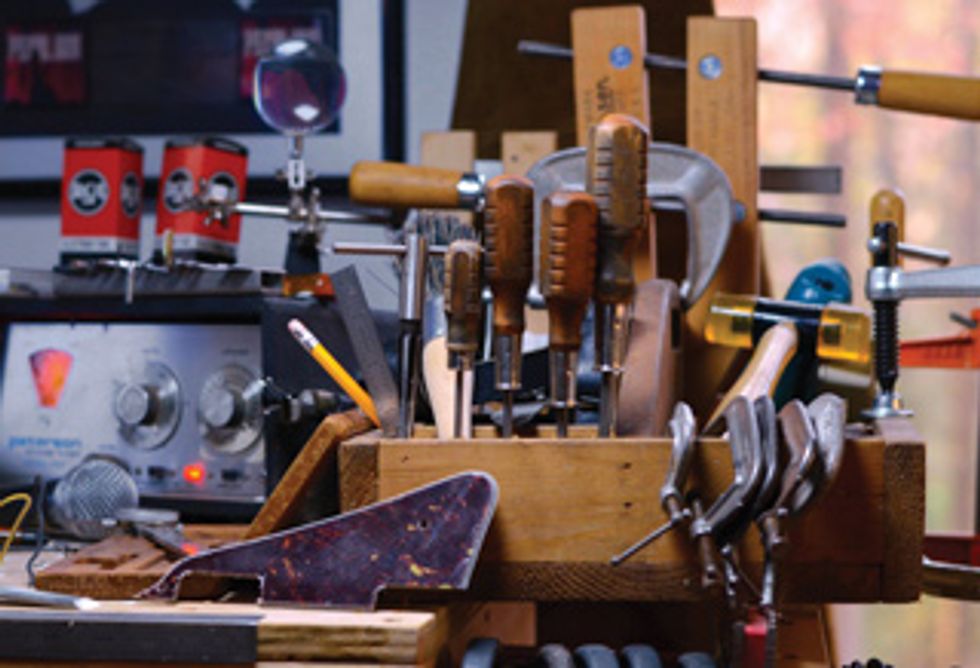
Guidance from resources such as Premier Guitar can be the most valuable tool at your workbench.
You’re lucky to be reading this. No, not because my column is full of wonderful, enlightened words, but because Premier Guitar as a whole is an invaluable tool. I wish that this much expertise and information had been so easily accessible when I was starting out. Actually, I wish guidance like what’s contained in PG’s offerings had been around for some of my clients over the years. It would have saved us all a lot of heartache! The answers to subjects like matching speaker impedance, adjusting amp bias, or even slotting a string nut are right at hand today—making it difficult to believe that they once seemed like black art to the average musician.
While still in high school, a friend and I embarked upon the creation of an amplifier company in the basement of my parent’s apartment building. We had successfully built several speaker cabinets, so it seemed logical to move on to amplifiers. With a rudimentary understanding of electronics—and a lot of optimism—we forged ahead in the dark. My friend was a ham-radio fiend who had successfully transferred his skill at mending radios to butchering the power supply of my first Marshall amp. How could we fail? The process dragged on slowly as I leveraged my growing collection of amplifiers into a rental service.
Graduation came and went with no finished amplifier, but we still pressed on. A few years later, my job at a small manufacturer of test equipment provided us with access to electronics distributors, and introduced me to the Thomas Register. Before Google, or even the internet, the Thomas Register was the way purchasing agents and designers found components and services. Sort of like “yellow pages” for the industry, it was a hardbound, multi-volume encyclopedia of goods and services in the U.S., and I loved it. If you needed a capacitor, metal chassis, or someone who did chrome plating, all you had to do was look it up.
It was this young gearhead’s delight to spend hours simply poring over the descriptions of stuff. The only problem was that you had to know what you were looking for. Without 15 different YouTube videos on how to select a power cable, I was forced to read actual electronics textbooks (very dry stuff when you’re anxious to build the world’s next greatest anything). With no money and even fewer organizational skills, my partner and I parted ways before a decent prototype was deemed marketable. It was probably for the best, but the exercise had a lasting effect.
Another of my many early jobs was as a “technician” and delivery driver for a place called Music Dealer Service in Chicago. My duties included simple setups on guitars, changing out blown speakers, and driving a delivery truck. MDS was where all the music shops in Chicago sent both their in- and out-of-warranty repairs, and we had our hands on everything imaginable, new and old. It was here I was exposed to people who actually understood how guitars and amplifiers worked, and I was in awe of their skill. I had my nose in everything because I wanted to learn more than how to carry a Fender Rhodes up four flights of stairs. Most of these guys were graduates of technical schools like DeVry and the Illinois Institute of Technology, and they spoke a language reserved for the geekiest of engineer/musicians, but I still managed to absorb a few basic things before moving on.
When involved in creating my first custom instrument some time later, a repairman named John Montgomery mentored me. Monte was a crusty old salt who had learned repair by doing. He was well versed in brass and woodwind upkeep, as well as basic finishing and crack repair on stringed instruments. Once again, the opportunity to learn presented itself by challenging Monte to help build a bass with me. But when it came time to inlay the fretboard, we were stumped, so I enlisted the help of a local luthier named Bozo Podunavac.
Although Podunavac was known for his acoustic guitars, especially 12-strings, his trademark was copious use of inlay. Apprenticing for years in his native Yugoslavia, Podunavac learned his craft the old-fashioned way by studying with a master. And after emigrating to the United States in 1959, he worked in a repair shop before striking out on his own in 1964. I was fascinated by the idea of building guitars from scratch, and seeing it firsthand was exciting. Here was a guy who clearly had a vision and the skills to bring that vision to life, and it was the first time that the entire picture was presented before me. As long as I kept learning, it was truly a great adventure.
Over the decades, I’ve been lucky to have the opportunity to compare notes, work with, and ask questions of some extremely talented and knowledgeable guitar people. I’d like to think that a small bit of it has rubbed off on me. This (and a lot of trial and error) has served me to a point where I might have something to share as well. Some cynics say that the world is getting broader but shallower, and that the depth of knowledge that comes from studying a single subject has given way to a kind of generalism. Would I have learned as much if I’d had access to something like the internet, or even a Stewart-MacDonald catalog? It’s hard to say, but it doesn’t surprise me how many people are thirsty for information. And having this resource at your fingertips is more focused than rummaging blindly through the pages of the Thomas Register.
 Jol Dantzig is a
noted designer, builder,
and player who co-founded
Hamer Guitars,
one of the first boutique
guitar brands, in 1973.
Today, as the director of
Dantzig Guitar Design, he continues to
help define the art of custom guitar. To
learn more, visit guitardesigner.com.
Jol Dantzig is a
noted designer, builder,
and player who co-founded
Hamer Guitars,
one of the first boutique
guitar brands, in 1973.
Today, as the director of
Dantzig Guitar Design, he continues to
help define the art of custom guitar. To
learn more, visit guitardesigner.com.

























